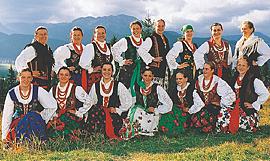| |||
POLANIORZE | |
|
góralski zespół regionalny | |
 | |
|
Zespół Polaniorze z Kościeliska został założony przez działaczy Oddziału Związku Podhalan w Kościelisku w 1977 roku. Nazwa zespołu pochodzi od dawnej nazwy wsi - Polany. Trzon zespołu stanowili muzycy i tancerze rozwiązanego zespołu regionalnego działającego przy Wojskowych Domach Wczasowych w Kościelisku. Kierownikiem zespołu był Andrzej Pitoń Kubów i Józef Bukowski Tyrała, instruktorami zaś Tadeusz Bukowski i Andrzej Gąsienica Buk. Swoja autentycznością i żywiołowością w przekazywaniu obrazów z życia polaniarskiej wsi podbijali publiczność i jury wielu przeglądów i festiwali. W 1978 roku zdobyli Złotą Ciupagę na Międzynarodowym Festiwalu Folkloru Ziem Górskich w Zakopanem. Członkowie zespołu brali udział w filmach np. Ród Gąsieniców. W ciągu kilku lat przedstawiali tradycje i zwyczaje w wielu miastach Polski i za granicą. Po wyjeździe kierownika Andrzeja Pitonia do USA zespół działał jeszcze kilka lat występując sporadycznie. W tym okresie prowadził go Wacław Przeklasa i Wojciech Karpiel. Zespół został reaktywowany 27 czerwca 1998 roku, a jego prowadzenia podjęli się Maria i Stanisław Krupowie. Zespół liczy obecnie 60 osób i brał już udział w kilku festiwalach w kraju i za granicą. W lipcu bieżącego roku występował w Berlinie, a w sierpniu na festiwalu w Madrycie. Zespół stara się godnie kultywować tańce, śpiew i tradycje naszych przodków. | |
The Polaniorze Ensemble was created in 1977 by the activists of the Highlanders’ Union (Związek Podhalan) at Kościelisko. |
Das Ensemble Polaniorze von Kościelisko wurde von den Aktivisten der Abteilung des Podhalanie Verbandes in Kościelisko im Jahr 1977 gegründet. Der Name des Ensembles ist auf den alten Namen des Dorfes - Polany, was so viel wie Almen, Bergweiden bedeutet, zurückzuführen. |
 |  |
| fotografie: © 2000 Paweł Murzyn | |
| << back / powrót << powrót do strony głównej | |
